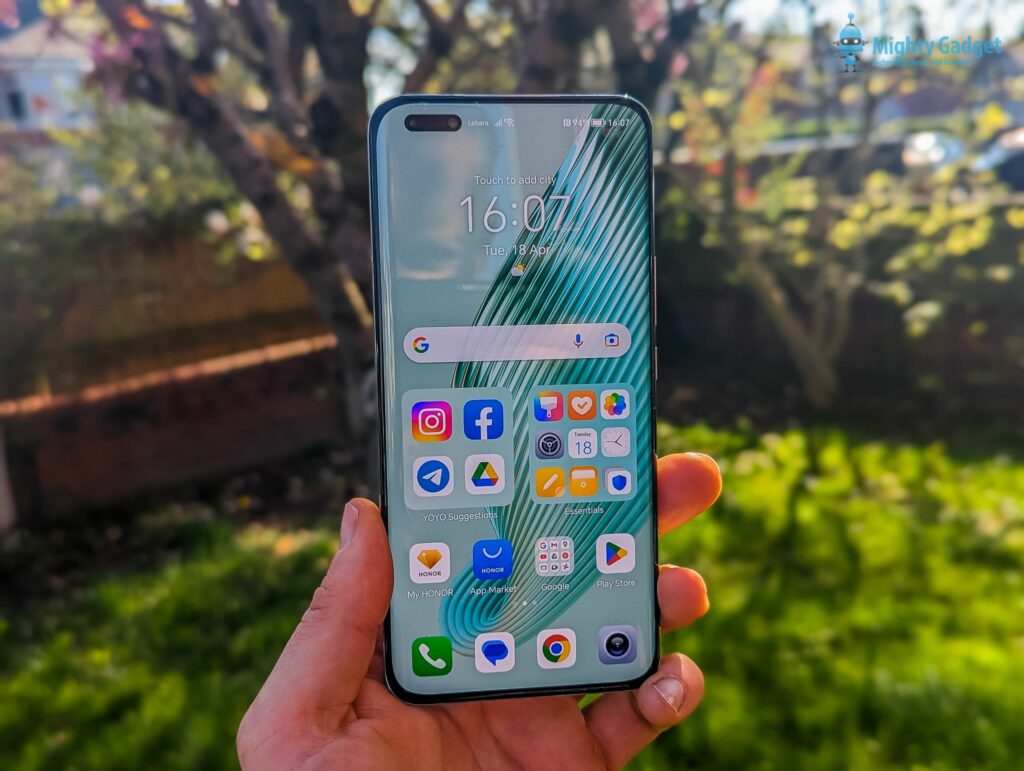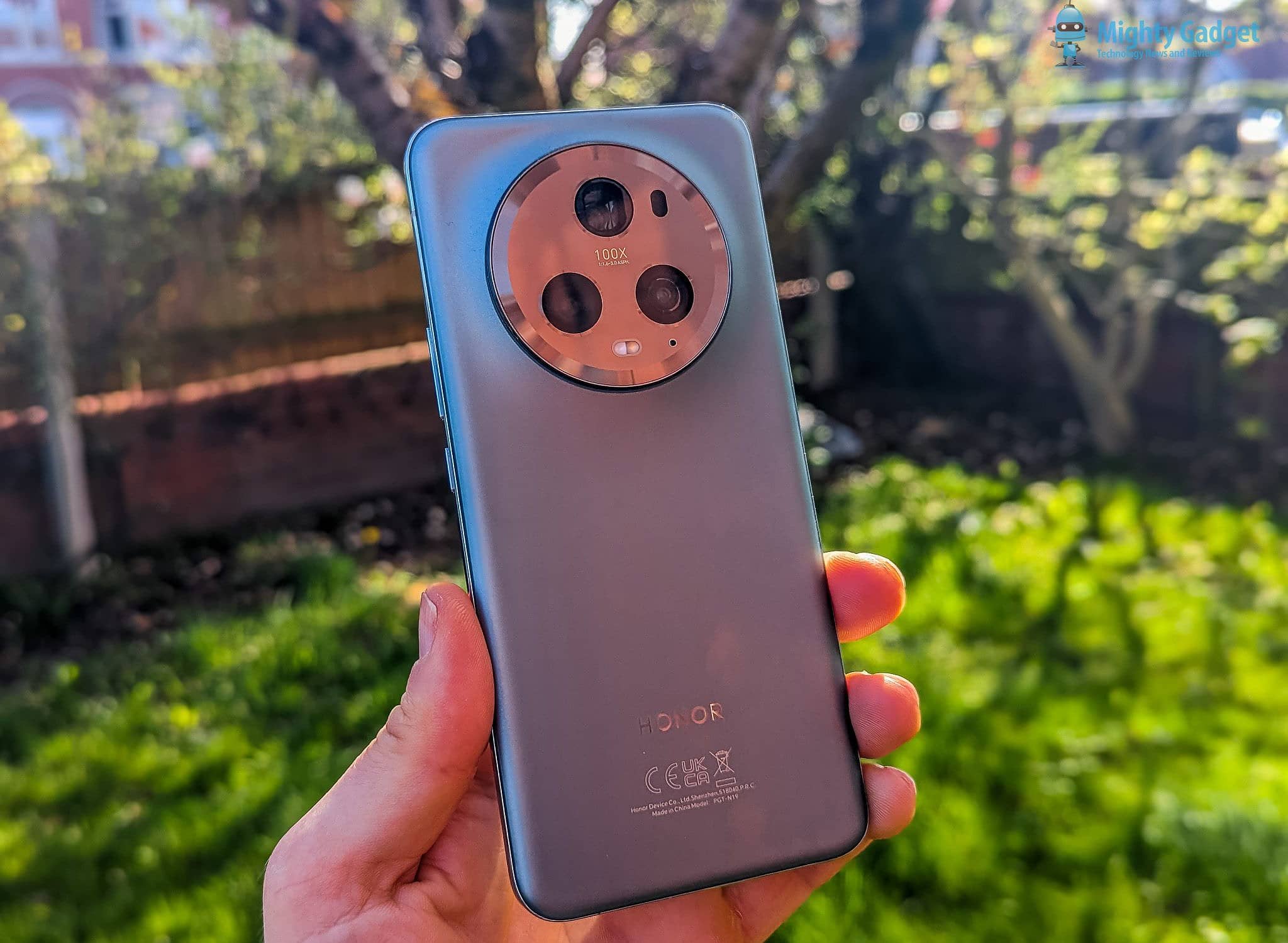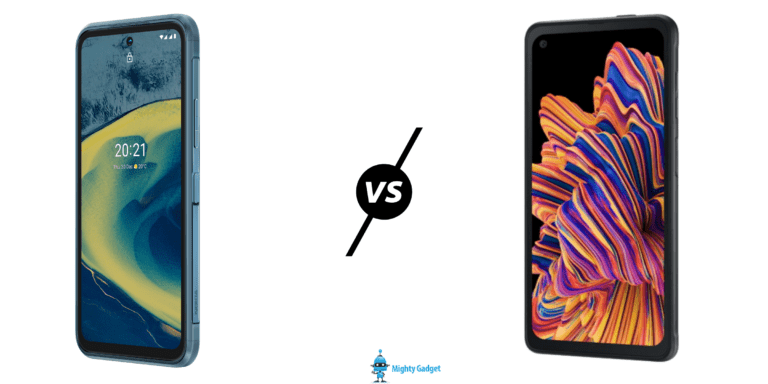Any links to online stores should be assumed to be affiliates. The company or PR agency provides all or most review samples. They have no control over my content, and I provide my honest opinion.
The Honor Magic4 Pro was one of my favourite phones of last year, which managed to combine a high specification and all-around performance without breaking the £1k mark that competing phones cost.
The Honor Magic5 Pro follows this trend. It launched at the same £949 RRP as last year, and Honor have refined the phone to make it even more competitive against competing and more expensive flagship phones.
Honor Magic5 Pro vs Magic4 Pro Specification
| Honor | Magic5 Pro | Magic4 Pro |
|---|---|---|
| Display | LTPO OLED, 1B colors, 120Hz, HDR10+, 1800 nits (peak) 6.81 inches, 113.7 cm2 (~91.0% screen-to-body ratio) 1312 x 2848 pixels, 19.5:9 ratio (~460 ppi density) | LTPO OLED, 1B colors, 120Hz, HDR10+, 1000 nits (peak) 6.81 inches, 113.7 cm2 (~93.0% screen-to-body ratio) 1312 x 2848 pixels, 19.5:9 ratio (~460 ppi density) |
| Chipset | Qualcomm Snapdragon 8 Gen 2 | Qualcomm Snapdragon 8 Gen 1 |
| RAM | 12GB | 8GB |
| Storage | 512GB | 256GB |
| Rear Cameras | 50 MP, f/1.6, 23mm (wide), 1/1.12" 1.4µm, multi-directional PDAF, Laser AF, OIS 50 MP, f/3.0, 90mm (periscope telephoto), PDAF, OIS, 3.5x optical zoom 50 MP, f/2.0, 13mm, 122˚ (ultrawide), 1/2.5", AF TOF 3D (depth) | 50 MP Sony IMX766, f/1.8, 23mm (wide), 1/1.56″, 1.0µm, multi-directional PDAF, Laser AF 50 MP, f/2.2, 122˚ (ultrawide), 1/2.5″ 64 MP, f/3.5, 90mm (periscope telephoto), 1/2.0″, 0.7µm, PDAF, OIS, 3.5x optical zoom TOF 3D (depth) |
| Front Camera | 12 MP, f/2.4, 100˚ (ultrawide), 1.22µm TOF 3D, (depth/biometrics sensor) | 12 MP, f/2.4, 100˚ (ultrawide), 1.22µm TOF 3D, (depth/biometrics sensor) |
| Battery | 5100 mAh | 4600 mAh |
| Charging | 66W wired 50W wireless Reverse wireless 5W reverse wired | 100W wired 100W wireless SuperCharge (separate purchase) |
| Protection | IP68 | Aluminosilicate glass IP68 |
Honor Magic5 Pro vs Magic4 Pro Key Differences
The Honor Magic5 Pro is a logical evolution to the excellent Honor Magic4 Pro that launched last year.
As you’d expect, the chipset has been upgraded to the Qualcomm Snapdragon 8 Gen 2, which is not only a significant improvement in processing power, but the TSMC fabrication process allows this to be more efficient, drawing less power and producing less heat.
The cameras have had a significant upgrade with a new 50 MP Sony IMX878 1/1.12″ sensor for the main camera, which now also has OIS, which was a disappointing omission with the Magic4.
The 50MP OmniVision OV64B 1/2″ ultra wide-angle (122°) camera supports autofocus and has a 13mm lens with a brighter aperture – f/2.0 vs f/2.2 on the Magic4.
The periscope zoom lens switches from 64MP to the 50MP Sony IMX858 with f/3.0 vs f/3.5.
The display is mostly the same, but it has a significantly improved peak brightness of 1800 nits vs 1000 nits.
The battery has had its capacity increased by 11%, going from 4600mAh to 5100mAh. Annoyingly, the Chinese variant is even better with a new Silicon-carbon 5450 mAh battery.
Charge speeds have been decreased from 100W for both wired and wireless down to 66W wired and 50W wireless.
Also, there are different memory configurations, but my sample arrived with 12GB RAM and 512GB storage. I think this is the only variant sold in the UK, so it has had a decent upgrade from 8GB/256GB.
It is only a small negative, but one thing worth noting is that this phone only supports WiFi 6 and not the superior WiFi 6E with the 6GHz band. I don’t really need multi-gig WiFi speeds on my phone, so I am not too concerned, but it is an odd omission when some competing phones support WiFi 7.
Design and Display

The basic design of this phone is largely the same as last year, the dimensions have changed a millimetre here and there, but you wouldn’t be able to tell when holding it in your hand.
The main difference in the design is that Honor has tweaked the large circular camera bump. There is a slight curvature on the case where the camera is made, and the circular section the cameras are contained in now matches the colour of the case. Apparently, this design is inspired by Gaudi curves in architecture.

Honor ditched the design that made it look like there were five camera sensors. You now have the three circles for the sensors, then the flash and a small additional hole for what I assume is the TOF sensor.
The sample I was sent is an attractive matte green, which Honor calls Meadow Green, and I prefer this matte design to the shiny Cyan of last year as it doesn’t get smudged so easily.
Curved displays remain a contentious design choice. Aesthetically, they look great, and I personally quite like them. It makes gesture navigation easier as the screen starts right on the edge of the device. However, in some apps, it does create a bit of clipping on the UI.

The OLED display itself is excellent. It has a dynamic 120Hz refresh rate which uses LTPO to adjust the refresh rate from 1Hz to save battery life up to 120Hz when you are using the phone.
It has not been terribly sunny where I live, but thanks to the 1300nit display, I expect this phone will be easily usable on the brightest of days. When watching media, this is capable of 1800 nits when watching HDR content, and thanks to a dedicated display chipset, the phone can upscale SDR content to HDR, and HDR content to HDR10+.
I have become accustomed to larger displays, I know a lot of people yearn for something smaller, but phones have become one of the primary ways we use the Internet, whether it is consuming media, browsing websites, or replying to emails. The added size makes all this a more enjoyable experience.

It is not a feature I personally use, but you get a handy IR blaster built into the top of the phone, allowing you to use apps to program the phone to control electronics like your TV and AV receiver.
My daily phone is the Pixel 6, and I loathe the fingerprint scanner and lack of facial recognition unlocking. This phone is the complete opposite, the fingerprint scanner is fast and accurate, and I rarely need to use it thanks to the excellent face unlock performance. Thanks to the TOF 3D sensor on the front camera, this unlock method should be more accurate and more secure than competing brands. Though this does mean you have a double-width punch hole in the display.

Camera

I have covered the camera performance in a bit more detail in a separate post.
Just like last year, and with most flagship phones, this has an excellent three-camera setup. This comprises of a 50MP customised 1/1.12″ sensor (IMX878) and has optical image stabilisation.
Then a 50MP ultra wide-angle (122°) is now based on the excellent Sony IMX858 sensor.
On the front, you have the same 12-megapixel, f/2.4 unit paired with a 3D depth that was used on the Magic 4 Pro.
There are some nifty features with the camera, including an AI Motion Sensing Capture feature designed to recognise when action occurs and automatically take photos when it detects key moments. If you do tap the shutter button, it will identify the best frames around the time you tapped the button to determine the best photo.
For photos, this is an excellent well, rounded phone. Phones like the Pixel may have superior software processing allowing the primary camera to perform a bit better, especially in difficult lighting situations. But this has superior hardware for the zoom and ultrawide lens, making it a bit more versatile.
I was particularly impressed with the zoom lens. Phones like the Samsung Galaxy 23 Ultra may have a fancy 10x and 3x zoom lens configuration, but I personally think the results from these are not amazing. You may be limited to 3.5x on this phone, but it is a better-quality picture. When using the camera, there is a toggle to jump to 10x zoom, and the performance is quite good, but you can easily see how the quality deteriorates due to the digital zoom.
Video performance is good, and you can capture up to 4K@60fps. While the main camera has OIS, I noticed a bit of shakiness when I recorded some footage. This was more my shaky hands, but I realised there were no video stablisation options that you get with some other phones.
Some video features are not available when shooting at 4K or 60FPS.
Photo Gallery












Portrait Mode Comparison with Pixel 6


Zoom Sample



Performance and Thermal Throttling

I have done a separate post going into detail with benchmarks and thermal throttling with the Qualcomm Snapdragon 8 Gen 2 on this phone in comparison to the Gen 1 on the Honor Magic4 Pro.
The benchmarks show what you would expect for performance, there is a significant improvement in the scores achieved across the board for CPU, GPU, memory and storage tests.
I would say, more importantly, the Snapdragon 8 Gen 2 is fabricated on the superior TSMC 4nm fabrication process, compared to Samsung last year. The result is that the phone uses less power and generates less heat for the results it achieves. Stress testing shows it can handle sustained performance for longer periods but gets nowhere near as hot as the Magic4 Pro while also using up less battery.
The performance of flagship chipsets is always impressive regardless of the phone it is on, and there is no scenario where this phone ever feels slow. The combination of the 120Hz display and powerful chipset means everything is smooth and responsive.
While this may not compete with phones like the Redmagic 8 Pro for the absolute best gaming performance, you are not going to be disappointed. The stress testing shows this does thermal throttle in comparison to the Redmagic, but during the few hours I gamed with this phone, there is no perceivable real-world difference.
Battery
I am the sort of person that has permanent battery anxiety. When the SD888 launched, and the subsequent Snapdragon 8 Gen 1, we saw battery performance drop from previous generations. After a year of use, I struggle to get through a full day of light to moderate usage with my Pixel 6, which uses the Google Tensor chipset.
I’d say this was one of the weak spots with the Magic4 Pro. You had that power-hungry chipset paired up with a 4600 mAh battery, which is starting to look a bit small by modern standards.
Honor obviously realised this and equipped the Magic5 Pro with a more capable 5100 mAh battery. Combine this with the more efficient SD8 Gen2, and you have a phone that should last much longer. My benchmarks with PCMark indicated that this achieved 13 hours 38 minutes runtime, an additional 3 hours compared to the previous generation.
During my testing, I have been very happy with the battery. I may not have all my apps installed and running in the background yet, but I have been hammering the camera, and it still gets through a full day easily.
Price and Alternative Options
The Honor Magic5 Pro has an RRP of £949.99. This review comes after the launch date, but they had an £80 early bird voucher plus several free gifts, including the 50W wireless charger.
The 256GB variant of the Pixel 7 Pro is the same price. The overall hardware is inferior, but the Google do a good job of making a phone greater than the sum of its parts. In particular, the camera performance is excellent but may not be as good as the Honor for the zoom and ultrawide.
The closest Samsung Galaxy S23 is the 6.1″ Galaxy S23 with with 8GB/256GB. This has significantly inferior hardware. The Honor Magic5 Pro holds its own against the S23 ultra, which will set you back a minimum of £1249.
The best alternative is likely to be the OnePlus 11, which is priced quite a bit cheaper at £799 for the 16 GB RAM + 256 GB Storage variant. I have not used it, but it has been widely well-reviewed. The camera specification is not quite as good, the display is a bit smaller and less bright, but higher resolution. It has incredibly fast 100W wired charging but no wireless.
Overall
The Honor Magic4 Pro was an excellent phone and showed promise that Honor could possibly fill the gap left by Huawei.
The Honor Magic5 Pro builds upon this, it is a superb phone, and Honor has done a good job improving the small number of features that could have been better on the Magic4 Pro.
The chipset is a big improvement, but that’s the case for all phones running this chipset, however, the bump in battery capacity is a very welcome improvement. It may not charge as fast, but there are hardly any scenarios where 66W wired is going to be unacceptable vs 100W.
The camera is perhaps the main area Honor has refined. The previous phone was good, but I found that in some conditions it wasn’t great. The Honor Magic5 Pro offers solid performance all around, and I am particularly impressed with the 3.5x zoom lens. The quality of the photos are not far off from what you expect from a primary camera.
Pricing is attractive too. At £949, it is the same price as the Pixel 7 Pro, and I’d argue it is a better phone. It is then much cheaper than the Xiaomi 13 Pro or the Samsung Galaxy S23 Ultra and even the S23+. I am not going to say this is a better phone than the Samsung Galaxy S23 Ultra, but is the S23 Ultra really worth the extra £300+?
For me, that price point is important, I have not yet come to terms with spending over a grand on a phone, so £950 is on the upper end of my budget.
Overall, I think the Honor Magic5 Pro is a superb phone, and I can highly recommend it. If I were to buy a flagship phone today, this would be it.
Honor Magic5 Pro Review Rating
Summary
Overall, I think the Honor Magic5 Pro is a superb phone, and I can highly recommend it. If I were to buy a flagship phone today, this would be it.
Overall
90%-
Overall - 90%90%
Pros
- Bigger batter and more efficient chipset allow this to last much longer than the previous generation
- Excellent camera performance with a superb zoom lens
Cons
- Slowing charging vs last year
- WiFi limited to WiFi 6
I am James, a UK-based tech enthusiast and the Editor and Owner of Mighty Gadget, which I’ve proudly run since 2007. Passionate about all things technology, my expertise spans from computers and networking to mobile, wearables, and smart home devices.
As a fitness fanatic who loves running and cycling, I also have a keen interest in fitness-related technology, and I take every opportunity to cover this niche on my blog. My diverse interests allow me to bring a unique perspective to tech blogging, merging lifestyle, fitness, and the latest tech trends.
In my academic pursuits, I earned a BSc in Information Systems Design from UCLAN, before advancing my learning with a Master’s Degree in Computing. This advanced study also included Cisco CCNA accreditation, further demonstrating my commitment to understanding and staying ahead of the technology curve.
I’m proud to share that Vuelio has consistently ranked Mighty Gadget as one of the top technology blogs in the UK. With my dedication to technology and drive to share my insights, I aim to continue providing my readers with engaging and informative content.







